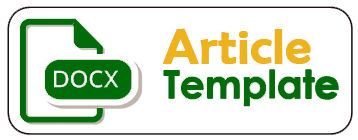Design of E-marketing Website as a Media for the Dissemination of Information and Product Marketing at PT. AJISAKA Semarang
DOI:
https://doi.org/10.32497/jobs.v10i1.6229Keywords:
E-marketing, Website, Real Estate, MarketingAbstract
Consumer lifestyle have been transformed by technology that provides online services for users to create networks where they can share and access information quickly. Real estate companies like PT. AJISAKA are required to adapt in the modern era to reach target audiences and promote their products by running digital marketing, one of which is with a web-based platform. The purposeof this research is to provide an e-marketing website as a medium for disseminating informationmand marketing product. The e-marketing website is expected to support the efficiency and effectiveness of the company”™s promotional activities. The method used in this research is System Development Life Cycle (SDLC) and built with Content Management System (CMS) WordPress. The result of this e-marketing website design is to create an infromation dissemination media platform that is easy to use to promote products that is user friendly and provides complete information. In addition, the e-marketing website is able to provide comfort for visitors because it can be accessed easily from a variety of devicesReferences
Badan Pusat Statistik Indonesia (BPS). 2021. Statistik E-commerce 2021. https://www.bps.go.id/id/publication/2021/12/17/667821e67421afd2c81c574b/statistik-e-commerce-2021.html (15 Februari 2021).
Broad, J. (2013). Chapter 5 - System Development Life Cycle (SDLC). In J. Broad (Ed.), Risk Management Framework (pp. 39-45). Boston: Syngress.
Bryukhovetskaya, S. V., Artamonova, K. A., et. al. (2020). Management of digital technology development in the national economy. IOP Conference Series: Earth and Environmental Science, 421(4), 042018. doi:10.1088/1755-1315/421/4/042018
Busalim, A. H., Hussin, A. R. C., et. al. (2019). Factors Influencing Customer Engagement in Social Commerce Websites: A Systematic Literature Review. Journal of Theoretical and Applied Electronic Commerce Research, 14(2), 1-14. Retrieved from doi:10.4067/S0718-18762019000200102
Eva Purnamasari, A. A. B., Eko Cahyo Mayndarto. (2023). The Impact Of Privacy, Security, And Trust On Online Transaction Intentions At Bank BCA Bandung. International Journal of Economics and Management Research, 02, 215-222.
Gao, P., Meng, F., et. al. (2021). Trends and Future Research in Electronic Marketing: A Bibliometric Analysis of Twenty Years. Journal of Theoretical and Applied Electronic Commerce Research, 16(5), 1667-1679. Retrieved from doi:10.3390/jtaer16050094
Judit oláH, Yusmar Ardhi Hidayat, et. al. (2019). Market structure and concentration ratio: evidence of it coMpanies in Hungary. Forum Scientiae Oeconomia, 07. doi:10.23762/fso_vol7_no3_1
Pounder, P. (2022). Leadership and information dissemination: challenges and opportunities in COVID-19. International Journal of Public Leadership, 18(2), 151-172. doi:10.1108/IJPL-05-2021-0030
Sadiku, P. O., Ogundokun, R. O., et. al. (2021). Interactive website on information dissemination. TELKOMNIKA (Telecommunication Computing Electronics and Control), 19(1). doi:10.12928/telkomnika.v19i1.15048
Salvator, M., & Heremba, N. K. (2023). Efektivitas Penyebaran Informasi Publik Melalui Website oleh Dinas Komunikasi dan Informatika Kabupaten Ngada. Jurnal Terapan Pemerintahan Minangkabau, 3(1), 42-55.
Ullah, F., Sepasgozar, S. M. E., et. al. (2021). Modelling users”™ perception of the online real estate platforms in a digitally disruptive environment: An integrated KANO-SISQual approach. Telematics and Informatics, 63, 101660. doi:https://doi.org/10.1016/j.tele.2021.101660
Zhang, Y., Wang, L., et. al. (2016). Agricultural information dissemination using ICTs: A review and analysis of information dissemination models in China. Information Processing in Agriculture, 3(1), 17-29. doi:https://doi.org/10.1016/j.inpa.2015.11.002
Downloads
Published
Issue
Section
License
Copyright (c) 2025 JOBS (Jurnal Of Business Studies)

This work is licensed under a Creative Commons Attribution 4.0 International License.
Authors who publish with this journal agree to the following terms:
Authors retain copyright and grant the journal right of first publication with the work simultaneously licensed under a Creative Commons Attribution License that allows others to share the work with an acknowledgement of the work's authorship and initial publication in this journal.
Authors are able to enter into separate, additional contractual arrangements for the non-exclusive distribution of the journal's published version of the work (e.g., post it to an institutional repository or publish it in a book), with an acknowledgement of its initial publication in this journal.
Authors are permitted and encouraged to post their work online (e.g., in institutional repositories or on their website) prior to and during the submission process, as it can lead to productive exchanges, as well as earlier and greater citation of published work (See The Effect of Open Access).





